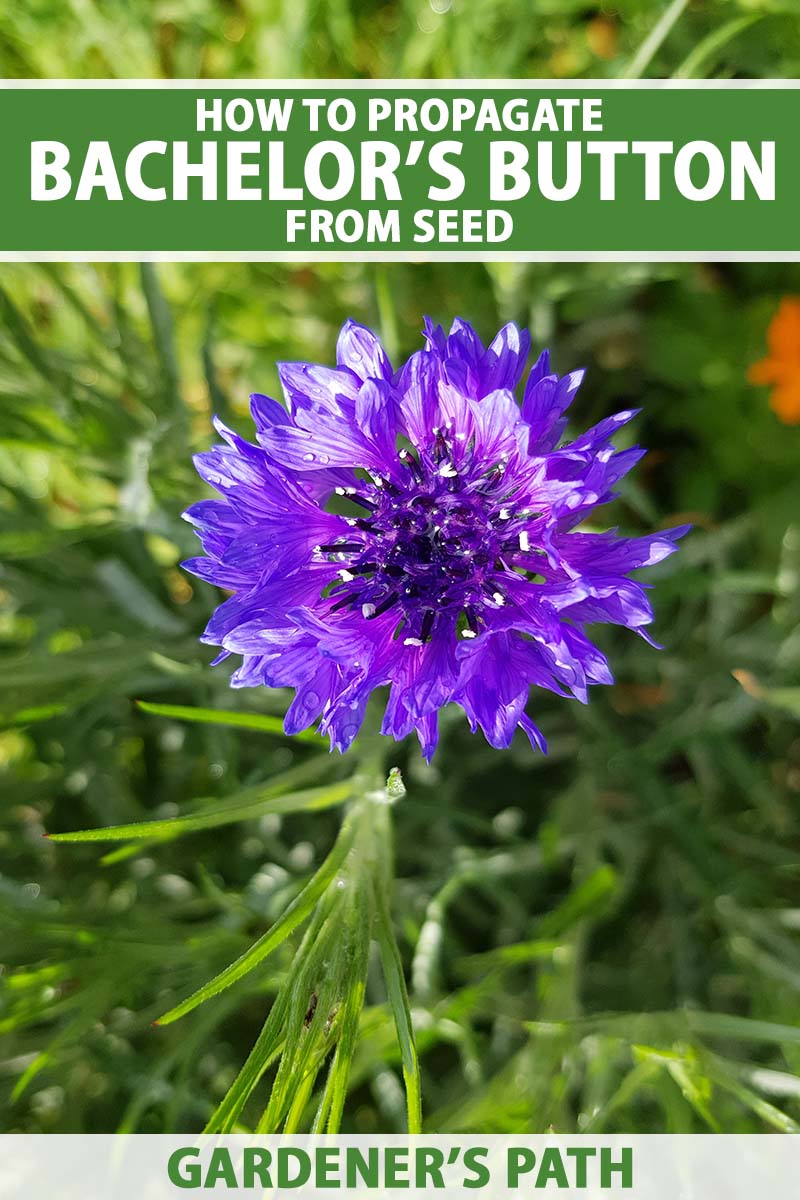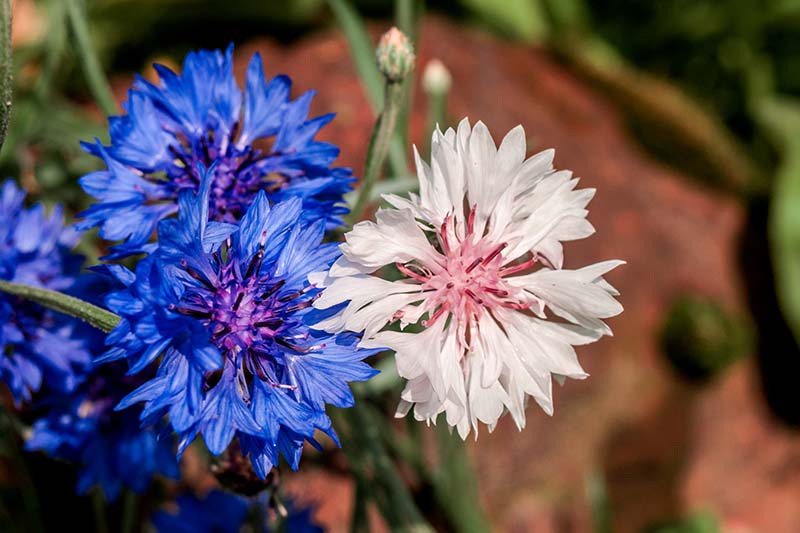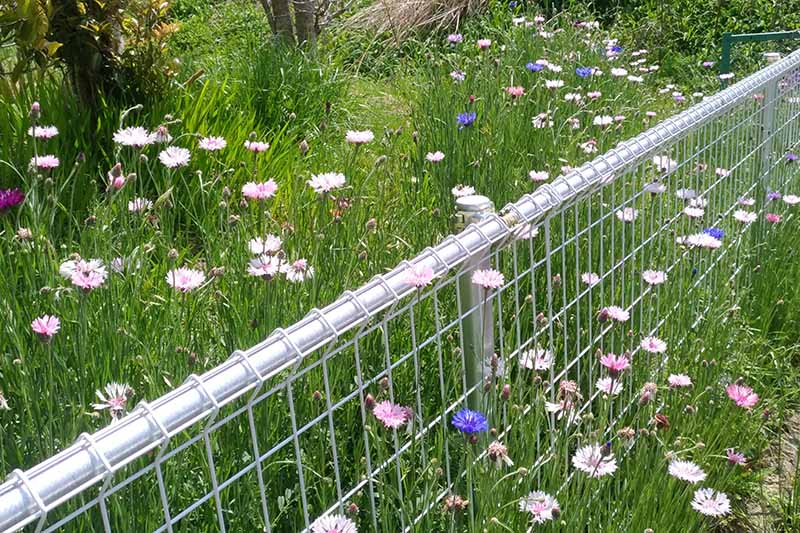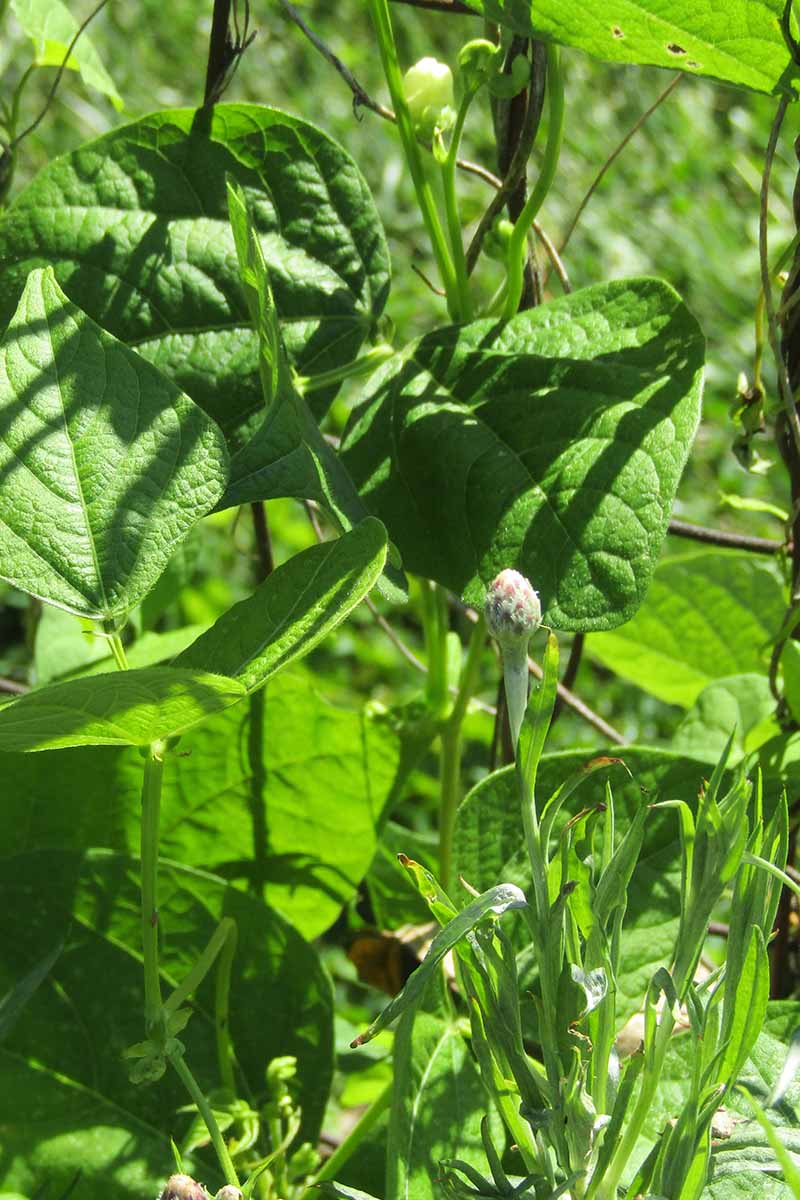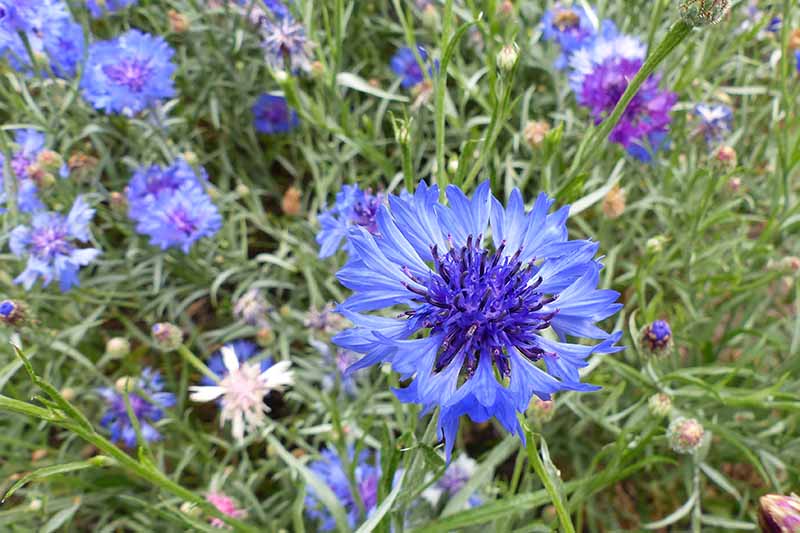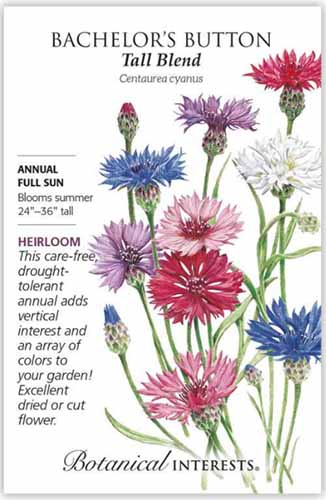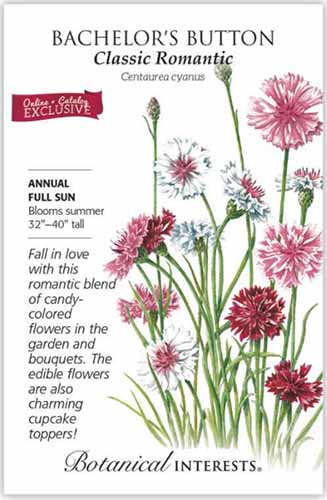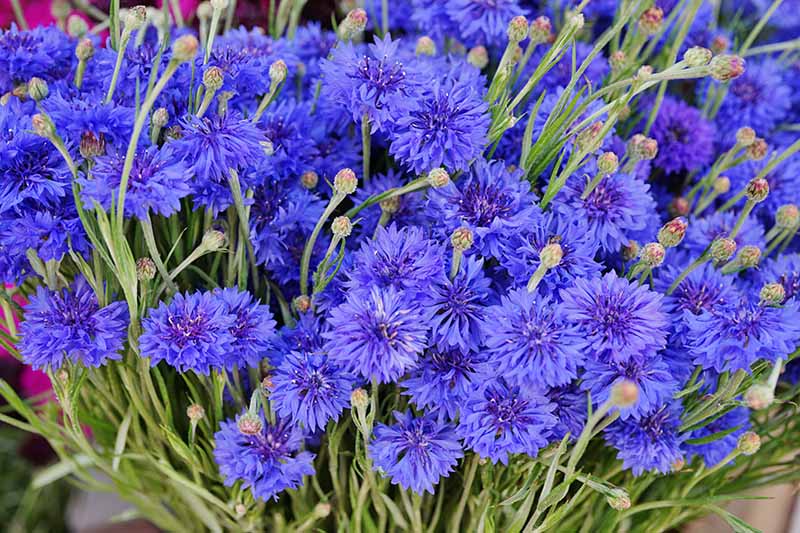I was a kid in Williamsburg, Virginia, which had long springs and sandy soil. In those days, I would carefully tend a small packet’s worth of these annuals in a four-by-four-foot garden plot, deadheading each spent bloom. We didn’t plant until June, and there would still be plenty to pick for our favorite teachers when we returned to school in September. We link to vendors to help you find relevant products. If you buy from one of our links, we may earn a commission. Often, birds planted them, or they self-seeded. Also new to me (gasp!), householders might mow the whole bunch of them in May – and the flowers often rebloomed in another carpet despite the insult. In the years since, I’ve adjusted my own planting methods to reflect those different growing conditions and the attitudes of each region’s gardeners. The experience has left me with a wide range of know-how about planting bachelor’s buttons from seed. I’d like to share some of that with you. Here are the tried-and-true lessons I’ll cover:
Bachelor’s Button Basics
With my affinity for Texas Hold ‘Em tournaments, big-screen late-model smart phones, bread machines, and that sort of thing, I’m seldom referred to as “old fashioned.” But my affection for heirloom bachelor’s buttons reveals my old-school side. These dainty annuals, with the botanical name Centaurea cyanus and the alias “cornflower,” are naturals for cottage gardens and country meadows. The full-sun plants fill up a space like wildflowers, sprouting reliably and quickly reaching anywhere from 12 inches to three feet tall. They have silvery-green leaves and disc-shaped blooms that are usually about an inch to two inches in diameter. The papery petals surround bracts, and many varieties have double blooms. The flowers look sweet and fresh, and would fit right into any episode of “Little House on the Prairie.” I’ve fashioned them into nosegays for simple gifts, and they’re just the thing for pressed or dried flowers or potpourri, because they retain most of their color. And let’s not forget their name. You can pluck a bloom to wear in a buttonhole or pinned to your jacket – and I assure you, you needn’t be a bachelor to sport this style. So many of their uses call to mind a simpler time, but make no mistake about it: The plants have distinct benefits for the modern-day gardener. They’re deer resistant, for example, and usually power right through a drought once they’re established. Pollinators flock to them, which is extra valuable since they begin blooming in spring when pollen and nectar are so limited. And you can plant cornflowers in containers if you select a dwarf variety. For anyone considering catching up with the edible flower trend, these tough annuals are a good way to start, if you don’t use chemical sprays. Not only are the blossoms tasty, the blue, purple, or magenta colors can liven up anything from festive cakes to cream soups. Now that you know many of the ways to enjoy cornflowers, keep reading to learn how to grow them from seed.
Where to Plant
Native to Europe, where some countries have deemed them the national flower, bachelor’s buttons have made their way across North America. They are hardy in all the USDA Hardiness Zones from 2 to 11, so if you want to grow them and have some space, you’ll probably be able to. The seedlings are vigorous in the great outdoors, but they don’t take kindly to transplanting. So not only is it best to sow them directly, it’s usually the only option. Cornflowers will self-seed. In fact, they do this so readily they’re considered invasive in some areas. Checking local regulations before planting is recommended. And while it may seem odd to plan where to plant flowers that proliferate on their own, it pays off. They’ll have more blooms, get fuller, and resist disease when you sow them somewhere that they’ll have their needs met. No matter which type you want to plant or how you want to use the blooms, find a spot with full sun. That’s a must. Their preferred soil is a little alkaline, but they’ll do just fine in any with a pH from 6.6 to 7.5. Beyond that, to use them as bedding plants or in borders, make every attempt to provide well-draining soil. This will help your eventual plants to avoid the rusts and rots cornflowers are prone to. And consider that these annuals do like to spread. If you can’t accommodate this in your flower garden or along pathways, consider planting them in containers instead. Take a minute to think whether you’ll really keep up with deadheading as the spring and summer wear on before choosing a spot. If you don’t cut and dispose of the dry seed heads before they release into the wind, you may have a huge crop of flowers in places where you don’t want them next year. On the other hand, you may want to opt for a meadow of bachelor’s buttons if you have a spare lot or sunny space you’d like to convert from lawn to native plants. Look at both sides of the story, though. Wide open spaces are an appealing place for these heirlooms; they’re just plain beautiful in wave upon wave of full bloom. But those meadows don’t spring up without a concerted effort on your part for the first couple of growing seasons. It’s not just a matter of tossing a couple of handfuls of a mix and letting it fall where it may. You’ll need to cultivate the soil and weed some to make sure the seeds can make contact with the dirt. You may also need to pull weeds later in the season, to give the flowering plants plenty of air circulation. And while mature plants are drought resistant, newly sown seed needs consistent moisture until it sprouts, which can take seven to 10 days. Happily, bachelor’s button seeds are affordable in bulk, even when you need enough to blanket an entire vacant lot. I’ll share some tips for where to buy cornflowers in packets or sacks here in a little bit. First let’s look at how to plant.
When and How to Sow
If you live in an area with warm winters, you’ve got an enviable option for planting. You can sow the seeds in late summer or early fall, and they’ll bloom extra early in spring. Everyone else, though, should plant the seeds a couple of weeks before the last frost in your area. If you get going late and still want to plant them later in spring, recognize that the germination rates are going to be lower and you’ll need to work harder to keep the soil evenly moist until they sprout. Plant dwarf varieties close to the front of a border, and taller types towards the middle. Strive for a final spacing of eight to 10 inches, but start with two seeds in each spot at first. When the sprouts reach two inches tall, thin to the strongest one at eight- to 10-inch intervals. Sow the seeds about a quarter of an inch deep, covering them with finely sifted soil or even sand. They’ll need the dark to germinate, which usually takes seven to 10 days. Water them thoroughly after sowing, and keep the planting medium moist but not waterlogged until you see sprouts.
Growing On
Once the seedlings emerge, most of your work is done. Yay! The plants will grow healthier and have more blooms if you water them, but honestly, they’ll still produce plenty of flowers if you leave them alone. You might want to assist with water retention by applying a one- or two-inch layer of mulch when the seedlings are four to six inches tall. Be careful not to let the mulch touch the stems, though – that’s a surefire way to spread harmful pathogens and encourage insect pests. To learn more about the rare pests that could affect your dear cornflowers, see our full growing guide for this heirloom bedding plant. Make sure to cut the blooms often. That will make the plants fill out more and produce even more flowers. And whether you’re saving them to plant next year or want to keep them from spreading willy-nilly, deadhead the spent blooms once they turn brown.
Where to Find Seeds
If this is your first season growing bachelor’s buttons, it’s reassuring to know that by this time next year, you’ll probably have a healthy supply of seeds. But for rookie cornflower growers, or those who accidentally (or on purpose) skipped the seed-saving step, there are reputable vendors who have what you need. The taller types of cornflower, same as those I saw growing in side yards when I moved to Knoxville, are available in single colors and also mixes. These are the type you’ll want to plant in the middle of a border, perhaps next to snapdragons or other cottage-style annuals that grow a few feet tall. Eden Brothers offers ‘Tall Blue’ bachelor’s button seeds in sizes from a small packet up to a 10-pound sack. ‘Tall Blue’ This variety grows 30 to 36 inches tall and takes 60 to 90 days from sowing to bloom. I recommend it for cut flower arrangements, and the long stalks make it convenient to dry the blooms hanging upside down in a cool, dark place. Tall Blend Botanical Interests sells a “Tall Blend” of seeds in two-gram packets, and also an organic version. The collection includes purple, light blue, pink, and white flowers that grow two to three feet tall, and spread about a foot. Another option is ‘Early Victory,’ which is also blue and matures in 60 to 90 days. It’s got branching stems with double-daisy blooms that look like ruffled collars. ‘Early Victory’ This cultivar grows 30 to 36 inches tall. Eden Brothers sells ‘Early Victory’ seeds in various packet sizes. A “Classic Romantic” seed collection is exclusive to Botanical Interests, and sold in 750-milligram packets. Classic Romantic It has a cottage garden vibe, with a mix of one-inch single and double blooms in shades of red, rose, pink, and white. A portion of the mix is also comprised of rare bicolor bachelor’s buttons. Seeds are also available for more compact varieties, those that grow 12 to 24 inches tall and are ideal for containers and borders. The smaller types also pull double duty as part of a kitchen garden, adding color among the green, leafy herbs, and providing edible blooms, too. ‘Dwarf Blue,’ for example, has double flowers and is one to two feet at its final height. ‘Dwarf Blue’ It matures in between 60 and 90 days, and seeds are available from Eden Brothers in various packet sizes and in bulk. For an in-between size, True Leaf Market sells a mix of seeds for plants that attain 18 to 24 inches. They should be spaced six to nine inches apart. Mixed Colors These bushy, upright varieties bloom in blue, purple, magenta, lavender, and rose, and take 77 to 91 days from sowing to flowering. The mix is available in sizes as small as a three-gram packet, or approximately 600 seeds, and up to a one-pound sack.
A Seedy Solution for Early Spring Blooms
One of the earliest blooms in spring, bachelor’s buttons are also easy to preserve for potpourri and dried flower arrangements. So they’ll provide beauty for a long time, all for the price of a packet of seeds and minimal upkeep. If you’ve got some experience growing this lovely little plant already and you know its wildflower habits well, are there any special ways you like to enjoy the flowers? Please do share your suggestions, or questions about cornflowers, in the handy comments section below. And if you’re intrigued by this easy-to-grow annual, you’ll find lots of great ideas for growing and enjoying it when you read these bachelor’s button guides next:
Bachelor’s Button Problems: Why Are My Flowers Falling Over?How to Save Bachelor’s Button Seeds for Planting
